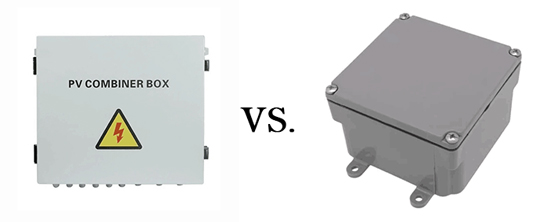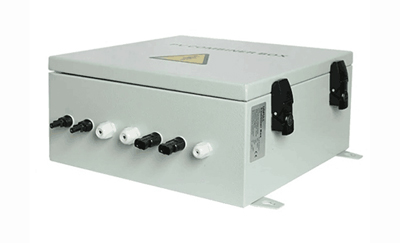PV Combiner Box vs. Junction Box
Solar power systems are intricate setups that require various components to function effectively. Two essential elements in these systems are the combiner box and the junction box. While they may sound similar, they serve distinct purposes. Let's delve into the key differences between a combiner box and a junction box:

Function
Combiner Box
- Purpose: The combiner box serves as a central consolidation point for the DC outputs of multiple solar panels. Its primary purpose is to streamline the individual electrical outputs from these panels before sending the combined power to the inverter. By combining the outputs in parallel, the combiner box maximizes the overall power output of the solar array.
- Connection: Combiner boxes are strategically placed between the solar panels and the inverter. They have multiple input terminals, each connected to a solar panel, allowing for the parallel connection of these panels.
Junction Box
- Purpose: The junction box is a component integrated directly into individual solar panels. Its main function is to protect the electrical connections within the solar panel. The junction box houses diodes that prevent reverse current flow, ensuring that the generated power moves in the intended direction.
- Connection: Junction boxes are part of each solar panel, managing the internal wiring and connections specific to that panel. They are typically mounted on the backside of the panel.
Location
Combiner Box
- Placement: Combiner boxes are usually located at a central point within the solar power system, often on the mounting structure or near the solar panel array. This central placement allows for the efficient consolidation of DC outputs before they reach the inverter.
- Multiple Inputs: Given their role in combining the outputs from multiple solar panels, combiner boxes have multiple input terminals to accommodate the connections from each panel.
Junction Box
- Integration: Junction boxes are physically integrated into each individual solar panel. They are typically positioned on the backside of the panel, providing a centralized location for managing the internal wiring and connections.
- Single Input/Output: Each solar panel is equipped with its own junction box, managing the connections and diodes specific to that panel.
Components
Combiner Box
- Components: Combiner boxes include various components to ensure safety and optimal system performance. These may include surge protection devices to guard against voltage surges, fuses to protect against overcurrent, and circuit breakers to disconnect the system in case of faults.
- Bus Bars: Internal bus bars are utilized within the combiner box to efficiently consolidate and channel the DC outputs from multiple solar panels.
Junction Box
- Components: The primary component within a junction box is the diode. Diodes prevent reverse current flow, ensuring that the generated power moves in the intended direction and does not dissipate back into the solar panel.
- Wiring Management: Junction boxes also include terminals for connecting the internal wiring of the solar panel, allowing for organized and secure management of electrical connections within the panel.
Safety and Monitoring
Combiner Box
Safety Features:
- Fuses: Combiner boxes are equipped with fuses that act as protective devices. These fuses are strategically placed in the circuit to interrupt the flow of current in the event of an overcurrent condition. This is crucial for preventing damage to the solar panels and other components in the system.
- Circuit Breakers: Similarly, circuit breakers are employed to provide a means of manually disconnecting the circuit. In case of a fault or maintenance requirement, the circuit breakers can be opened to isolate the combiner box from the rest of the system, enhancing safety during service.
- Surge Protection Devices: To safeguard the solar power system from voltage spikes and surges, combiner boxes often incorporate surge protection devices. These devices divert excess voltage away from the system, preventing damage to sensitive electronics.
Monitoring:
- Voltage Monitoring: Combiner boxes include voltage monitoring mechanisms to continuously assess the voltage levels from each solar panel. If a panel deviates from the specified voltage range, the combiner box can take corrective actions. This monitoring ensures that the system operates within safe parameters and allows for early detection of potential issues.
- Current Monitoring: Some advanced combiner boxes may also incorporate current monitoring features. Monitoring the current flow helps in identifying any abnormalities or imbalances in the system, allowing for timely intervention to maintain system integrity.
Junction Box
Safety Features:
- Diodes: The main safety feature within a junction box is the diode. Diodes prevent reverse current flow, ensuring that the generated power from the solar panel moves in the intended direction and does not dissipate back into the panel. This is crucial for preventing efficiency losses and potential damage to the solar panel.
- Weatherproofing: Junction boxes are often designed to be weatherproof, protecting the internal components from environmental factors such as moisture and dust. This weatherproofing enhances the longevity and reliability of the solar panel.
Monitoring:
- Basic Monitoring: While junction boxes are not typically equipped with extensive monitoring features, some advanced models may include basic monitoring capabilities. This could involve indicators or sensors that provide information about the overall health and performance of the solar panel.
- Temperature Monitoring: In some cases, junction boxes may include temperature sensors to monitor the temperature of the solar panel. Monitoring temperature is essential for assessing the operating conditions of the panel and ensuring it stays within the recommended range for optimal performance.
In summary, a combiner box is a central passive component that consolidates and manages the outputs from multiple solar panels, optimizing the efficiency of the entire system. In contrast, a junction box is an integral part of individual solar panels, safeguarding the internal connections and managing the electrical flow within each panel. Both components play crucial roles in ensuring the reliability and safety of solar power systems, albeit at different points in the system architecture.


